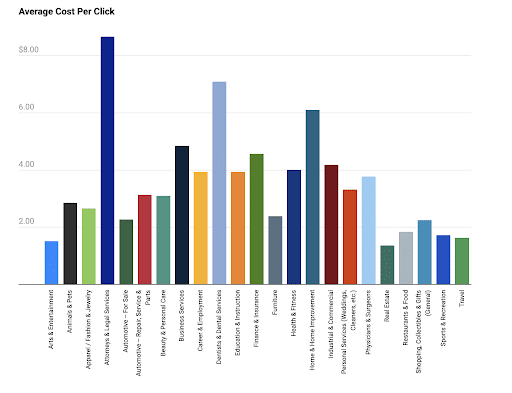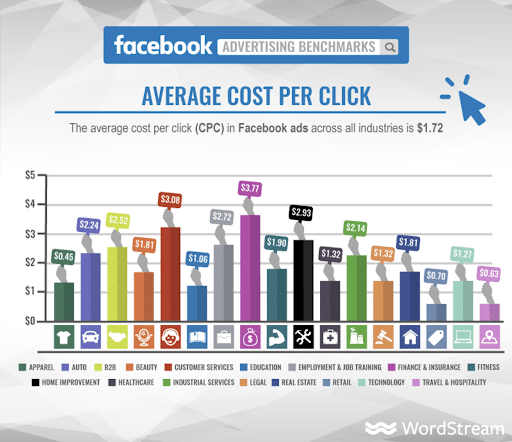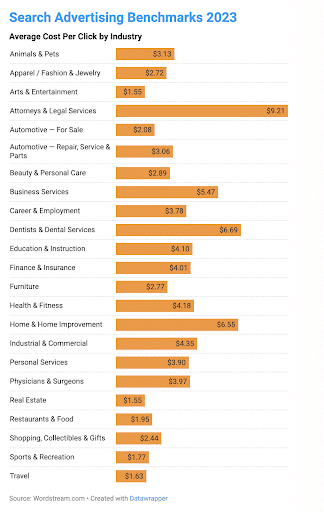Cost-per-click, or CPC, refers to the cost associated with running digital ads. With CPC advertising, brands do not pay a flat fee for their ads. Rather, they pay per click.
Estimates show advertising spending in the U.S. growing to $695.96 billion by 2024 and up to $835.82 billion by 2026.
And a massive chunk of that comes from pay-per-click, or PPC ad, campaigns.
But in order to understand that spend – and better yet, how much it will cost you as an advertiser – you need a working knowledge of cost-per-click or CPC.
In this article, I’ll explain exactly what CPC is, how it’s determined, and how you can lower your CPC and still maintain quality clicks.
What You’ll Learn:
As the world of online business grows, so does the need and industry of online advertisements.
According to Statista, advertising spending in the U.S. is estimated to grow to $835.82 billion dollars by 2026. And a massive chunk of that comes from what is known as pay-per-click or PPC ad campaigns.
What is CPC?
The term CPC stands for cost per click.
It’s a bidding model that means you pay a certain amount every time someone clicks on your ad.
Essentially, it is a method of billing that companies use to place online ads on various sites. However, the definition is often muddled a bit because the term is often used synonymously with PPC.
Therefore, to completely understand CPC advertising to its fullest, it is best first to know a few things about PPC advertisements and how they work.
PPC Basics
When you run an ad in the newspaper, on TV, or on a billboard around town, there is a price to take up that space. The same goes for when you put ads on websites online—you have to pay for that space.
Typically this is done one of two ways—CPM or PPC.
CPM, or cost per mille (the Latin and old French word for thousand), represents the number of impressions (viewers) in thousands that your ad receives, regardless of how many times it was actually clicked on.
However, with this model, if your ad runs on a well-frequented site, they could charge you could be charged thousands with no one actually paying attention to or clicking on your specific ad.
On the other hand, the PPC method is not concerned with how many people are exposed to your ad. It only charges you when someone clicks on your ad. This means you only pay for the people who actually take an action that is beneficial to you.
What is CPC: Cost Per Click in Detail
What is CPC in marketing? The CPC, which stands for cost per click, is the actual price paid each time someone clicks on one of your PPC ads or banners.
It’s most often used when advertisers or companies have a specific budget, usually a daily or monthly one.
Many different types of ads use a CPC or PPC model. This includes:
- Image ads
- Video ads
- Text ads
- Shopping ads
- Social media ads on Twitter, Instagram, LinkedIn, and Facebook
Some of these CPC ads are featured only on one site, such as Facebook ads, whereas others are featured across a variety of sites, such as the Display Network which includes Google, Google-owned, and partner sites).
Cost per click = Advertising cost/number of clicks
Once you have a maximum CPC in mind, you can start your campaign. If you’re using AdWords, Google recommends using a $1 maximum but you can adjust this to whatever matches your needs and budget. Your maximum budget can be set as a daily or monthly budget.
For example, let’s say you use a network that charges $1 per click, and your daily budget is set to $1000. That would mean that you could get only 1000 clicks per day.
After that number is reached, the website your ad is appearing on will simply remove your ad for the rest of the day.
Each click is a visit or type of communication with your website, landing page, or company product and shows how much attention your product or site is getting from the public.
When you invest in a PPC campaign of any kind, this is the attention you’re buying. Which means the cost per click is pretty significant. If you’re paying too much, the return on investment (ROI) will not be worth it and cause you to lose money instead.
However, underpaying is possible too. At first, it may seem like that means you’re saving money. But just like most things, you get what you pay for.
Paying less than average may seem ideal, but it may not be identifying and targeting clicks that are valuable to you. The key is to find clicks that are both of guaranteed quality and inexpensive.
Each network or ad company usually sets the CPC by a bidding process or a formula.
How is CPC Determined and Calculated for Each Network?
The CPC is the amount you pay to a website publisher when someone clicks on your ad.
However, most publishers use a third party to match and connect them to advertisers, such as yourself.
These third parties or networks, in contract with the publisher, determine how they’ll calculate CPC.
They also get a cut of the amount the advertiser pays.
The thing about CPC advertising though, is that each network has a different process. You’ll need to look at them individually before getting started.
For example, Google and many other networks use a bidding process to establish CPC.
When you advertise with them, you will bid on how much you’re willing to pay per click on ads with specific keywords.
Google then matches your ad and that keyword to a publisher. The more valuable the keyword and the higher the amount of traffic a website has, the higher the CPC will be.
Below I have listed a few of the most widely used networks and ad types out there, as well as how they determine your CPC.
Google Ads
Since Google is the most widely used search engine in the world, its ad network, Google Ads, is typically at the top of the list for online advertisements.
These ads may cost you more than Bing, but because more people see them, the chance of your ad being clicked on is typically higher.
Google allows you to place ads in the search results, on private websites, or both.
If you run ads on a private site, Google only gets a certain percentage of the CPC. However, if your ad is in search, they get all of it, as there is no publisher or website to pay.
Google Ads uses the following equation to calculate CPC:

Google Ads formula for CPC
Using the formula, if you have a quality score of 6 and the competitor below you in ad rank has a 12, your CPC is $2.01 for that specific ad.
CPC averages vary by industry. The industry with the highest CPC is legal services. Its CPC is almost $9. The industry with the lowest CPC is real estate and travel, averaging only $1.40.
CPC for AdWords in all industries is about $2.
Bing Ads
Using Bing, the second largest search engine, you can post ads through Bing, Microsoft, Yahoo, and their search partners.
Though second to Google in traffic, Bing still boasts about 655 million searchers per month. They also claim the ability to reach over 250 million users through native advertising.
Unlike Google, Bing offers a bit more flexibility in scheduling, location targeting, and budget. With Bing, you also gain access to the entire Microsoft Search Network, which includes Bing, AOL, and Yahoo. It also tends to have an older, more intelligent, and wealthier demographic or audience.
Because there isn’t as much competition on the channel, Bing can also give better ad positions for a lower CPC and typically have a higher ROI.
Bing also uses your quality score in relation to those who are bidding against you to give you an ad rank, which also determines where on the search results page your ad will appear. Bing then uses that ad rank to calculate your CPC for that specific ad.
Bing uses the following formula:

Bing’s formula for CPC
So, let’s say you have an ad rank of 6 in a particular auction, and the person right behind you in rank has an ad rank of 4. You have bid $2.
If we divide your competitor’s four by your 6 and then multiply that by two, you get a CPC of 1.33. Therefore, you will pay $1.33 every time someone clicks on that ad.
With Bing ads, Apparel & Accessories claimed the lowest CPC, with an average of $0.91. Real Estate had the highest at $2.88.
However, the average CPC across all industries on Bing is $1.54.
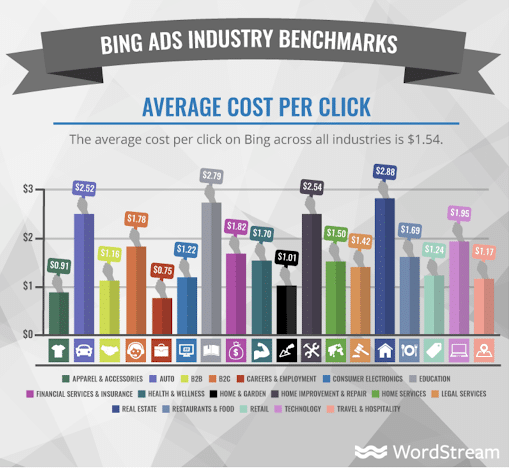
List of the average CPC on Bing per industry
Facebook Ads
Facebook, as the most popular social media network in the world, is another top place to run PPC ads. It’s also one of the best places to do so if you want to sell products or services based on particular interests or demographics.
A somewhat frustrating aspect of Facebook Ads is that its requirements are constantly changing. Even though it can be time-consuming, it is important to not only keep up with their changing CPC but also their changing rules. Not following these rules could affect your CPC, and even the status of your brand’s account, in the long run.
Facebook differs slightly from search engines in how they calculate CPC. While they still use an auction process, they do not consider quality scores or ad ranks.
Instead, they focus on the ad’s target audience.
Just like Google’s keywords, some target audiences cost more than others because of their popularity. They also figure in your budget or maximum bid, as well as the duration of the campaign.
Another important aspect of your Facebook Ad CPC is your ad relevancy score. Facebook gives this score based on the relevancy or positive or negative feedback it is expects your ad to receive.
Ads that are expected to be well-liked receive higher scores and are rewarded with lower running costs.
As people react to your ad, this score will continue to change based on those reactions. This means that your CPC is also constantly changing.
Facebook also gives you the option to set your CPC bids manually, instead of having them recommend or optimize it for you.
The average CPC on Facebook is around $1.72. Apparel has the lowest CPC here, with an average of $0.45 CPC. Financial advertisers see the highest CPC with $3.77 average per click.
Native Ads
These are ads that look like they’re part of a blog or private website. Outbrain and Taboola are two of the most popular native ad networks.
Google also has its own native ad platform called AdSense. It works through Google Ads and runs the same campaigns. The difference is that publishers primarily use it to monetize their site, instead of by advertisers looking to sell products.
For most native ad networks, the formula used to calculate CPC is much less complicated than those used by search engines such as Google or Bing.
In most cases, when you begin a new campaign with them, you can simply input your CPC based on how much you want to spend per day or month, depending on how you set up your budget.
However, some networks, like Outbrain, also offer a competitive CPC and budget setting that will automatically change your CPC slightly to be more in line with your overall goals, based on the actual conversions you get and not just the clicks.
With this type of PPC ad, you have more control of your own CPC. This means you will need to pay very close attention to it.
It also means you’re more likely to underpay. So be sure to set your CPC high enough that it is competitive and gets the desired amount of traffic to be worth your while.
CPCs for native ads can run anywhere from $0.05 up to nearly $5.00 depending on the content and competition available.
They tend to be more cost-effective because more people trust these ads. In fact, Outbrain suggests that 75% of viewers will trust native ads over those found on social media.
How to Lower Your CPC While Maintaining Value
The key to success with your PPC ads is to make sure you are paying the least amount possible per click while maintaining a high quality of clicks.
Here are a few ways to make sure you are doing just that.
Raise Your Quality and/or Relevance Score
Some networks, such as Google, offer discount CPC pricing to PPC campaigns with high-quality scores.
This means your ads are well-managed, have high click-through rates (CTR), including text, lead, and landing pages that are specific to search goals, and have closely related ad groups.
Currently, campaigns with quality scores of six or higher can get anywhere from 16-50% off their CPC. On the flip side, those with a score of four or below may pay more.
Facebook advertising calls it relevance score — when your ad’s relevance score is high, Facebook will show your CPC ads to more people.
You can improve your quality or relevance score by being specific with your ad targeting, as this is a key factor and requires narrowing down your perfect target audience.
Both Facebook and Google offer audience demographics reports that can help you do this.
Another way to improve your relevance score is to put more thought into the messaging and imagery used in your ads. Use A/B testing to see what really works for your audience.
This will help you increase your click-through rates. This is true for both Google Ads quality scores and Facebook relevance scores.
A higher expected CTR will raise your quality score, but on Facebook where you’re charged per thousand impressions, a higher click-through rate will help lower CPCs.
For more on how to raise your quality score, read my full article here.
Keyword Relevance
Besides everything else that goes into your CPC, keyword relevance also plays a big part. If you are using the wrong keywords, it could have a negative impact on your campaign.
If you start to notice that a specific keyword isn’t performing well, remove it from future ad campaigns. Instead, do more research on related keywords that will have a more positive impact on your CPC.
Another thing that is going to severely impact your CPC is the quality of your ad and/or landing page.
If your audience isn’t getting excited or intrigued by your ad, they aren’t going to click on it. Use appropriate colors, easy-to-read font, eye-catching images, and perfectly crafted copy to grab their attention and drive them to click.
The same goes for your landing page. If you get over the hurdle of getting a consumer to click on your ad, you also have to provide a quality landing page. Consumers will make a decision about your product or service within seconds of landing on your page. Make sure you make a good impression and inspire them to stay.
Quality of Your Ad & Your Landing Page
Another thing that is going to severely impact your CPC is the quality of your ad and/or landing page.
If your audience isn’t getting excited or intrigued by your ad, they aren’t going to click on it. Use appropriate colors, easy-to-read font, eye-catching images, and perfectly crafted copy to grab their attention and drive them to click.
The same goes for your landing page. If you get over the hurdle of getting a consumer to click on your ad, you also have to provide a quality landing page. Consumers will make a decision about your product or service within seconds of landing on your page. Make sure you make a good impression and inspire them to stay.
CPC Pros and Cons
Like any other type of advertising, CPC has a list of pros and cons.
Some of the great things about CPC advertising include:
- Only paying per click, instead of per exposure.
- The ability to successfully target your ad to your preferred audience.
- The ability to physically see your campaign’s effectiveness with a variety of statistics.
- The high-level customization options are available to advertisers.
However, CPC advertising also comes with some downsides. Cons of CPC advertising include:
- Acquiring the skills necessary to run an effective campaign. With so many different platforms, it can be difficult to keep up with the changing requirements.
- The fact is that clicks don’t always convert. There is still work to be done after you convince a consumer to click on your ad.
- There is a pretty decent time commitment involved in being successful with this type of campaign.
- The fact that you need to keep an eye on costs to ensure they don’t add up too quickly.
As with every business decision, be sure to weigh the pros and cons and how they apply to your business before deciding to move forward on this type of campaign.
What is a Good CPC?
A good CPC will vary by industry. You also need to consider things like keyword match, device type, competition, ad rank, and other factors.
Industry plays the biggest role in a brand’s CPC. But good news if you’re in a lower competition industry! Your CPC is typically going to be lower than a brand with a ton of competition.
It’s also going to vary depending on the platform. Bing tends to offer a lower CPC than Google – again because of the level of competition.
As a general rule of thumb, check out the chart below to see industry standards across the board.
As you can see, Attorneys & Legal Services has the highest CPC at $9.21 and Real Estate and Arts & Entertainment are tied at $1.55.
What is CPC: Examples of PPC Ads and How Much it Costs to Run Them
Now let’s look at a few examples.
These are all from Google Ads, where the importance lies in the keywords used, as opposed to Facebook, which puts more emphasis on the target audience.
The following are a few good examples of PPC ads and how much it costs to run them according to their CPC and keyword.
1. Sherwin Williams
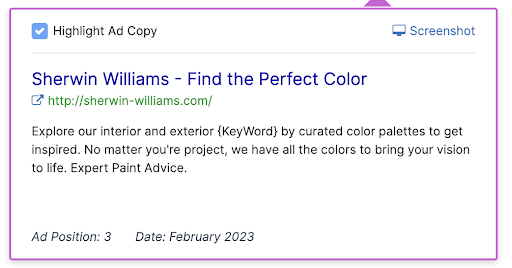
CPC Ad Examples: Sherwin Williams
This PPC ad for paint company Sherwin Williams uses the keyword “paint color” and has a CPC of $2.41.
Since Sherwin-Williams has a high ad rank and quality score, their ads run on the first page very near the top. This ensures they get the maximum exposure and number of clicks each month.
According to SpyFu, this ad gets about 52,800 clicks every month, costing BEHR around $127,000 per month.
2. Simplisafe
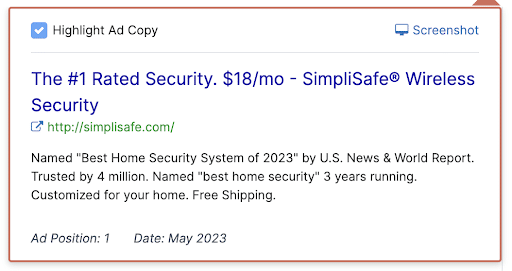
CPC ad example: SimpliSafe
This ad, compared to the one above, is much more expensive to run.
Here, SimpliSafe uses the keyword “home security systems.” The ad also shows in the number one ad position above the search results, which means that they have a high ad rank and quality score.
And yet, according to SpyFu, this ad’s CPC is $17.45, significantly more than that of the ad above. This means that the keyword is trendy and is in high demand.
However, it has a lower click rate than Sherwin Williams’ use of paint colors, with only 43,100 actual clicks, costing SimpliSafe about $752,000 a month for this ad campaign.
We also have to keep in mind the industry that it comes from, as home security tends to be a more expensive one compared to paint.
3. Dollar Shave Club
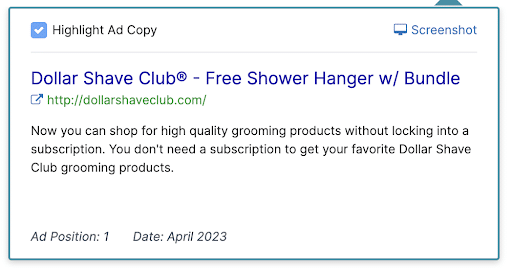
CPC ad examples: Dollar Shave Club
Dollar Shave Club used the keyword “shave club” in this ad. It placed first on the search results list and had a CPC of $5.48 for a monthly total of 6,670 clicks and $36,600. It also had a search volume of 27,100 searches a month.
But let’s look at another one of Dollar Shave Club other ad campaigns that use a narrower keyword:
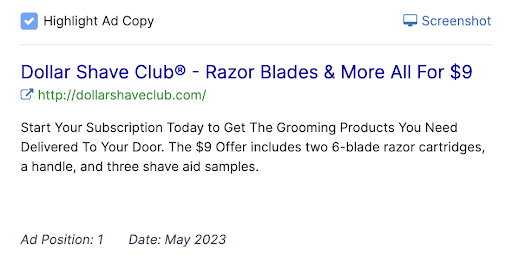
Another CPC example from Dollar Shave Club using a different keyword
This one uses “dollar shave” as the keyword, which will limit the results significantly to their brand.
Using this keyword places the ad at the very top of the page, as well as lowers its CPC to only $1.72. This ad was clicked on 2,500 times, giving it a monthly total of $4300.
Once again, the industry is essential to note. This one isn’t nearly as lucrative as the former ads, and so the average CPC for it is much lower.
You can see from these examples that while the ads all look similar and appear to have high ad ranks and quality scores with Google, they can differ significantly in cost to run.
Both industry type and keyword make a great deal of difference to the CPC and, therefore, the cost of each campaign.
Wrapping Up What is CPC
Now that you understand the basics of PPC ad campaigns and how much they can cost you based on the CPC, it’s time to get out there and begin creating advertisements that work for you and your business.
There are a lot of options out there, and only you will be able to fully determine how beneficial they will be.
Just remember, always keep track of your CPC and strive for it to be as low as possible while still being able to maintain high-quality clicks and values.
Frequently Asked Questions
1. Why is my CPC so high?
If you’re in an industry that has a high value per conversion then it is not uncommon to see occasionally high CPCs. Certain industries simply have more competitive advertisers who are willing to pay more per click. If that’s not you, there are a few things you can do to lower your CPC. Try raising your quality score, refining your reach and then expanding your reach.
2. What is a good CPC?
The short answer is, “it depends.” On average, you should be spending $20 per click on your ad, resulting in a 5% conversion rate. Of course, this also depends on your product or industry, as your ideal cost per click should be determined by your target ROI. For most businesses, a 5:1 revenue-to-ad-spend is considered just fine.
3. What is the maximum CPC?
Maximum CPC is the highest amount you’re willing to pay for a click on your ad. The maximum CPC set doesn’t necessarily mean it’s the amount you will actually pay for the click. If you’re not sure of what to choose for the highest amount per click, Google recommends setting the maximum CPC to $1 in Google AdWords.
4. What is manual CPC bidding?
In CPC advertising, manual CPC bidding occurs when advertisers place the maximum CPC for each ad by hand instead of enlisting the help of automated bidding strategies.
5. What is the enhanced CPC?
Enhanced CPC is an automated conversion bidding strategy in Google AdWords that adjusts your bids to help maximize ad conversions. It ultimately gives Google the power to automatically alter how much you’re bidding on keywords within that campaign.
6. Is it better to have a high or low CPC?
You want to aim toward having a low CPC. A lower CPC means you can stretch your budget further, which means more potential leads. It also works well with niche keywords that aren’t as competitive.
It’s important to think about your CPC in regard to what you’re selling in your ads. If an average sale earns your business $40 and your CPC is $20, there’s not a ton of opportunity for profit. But a lower CPC, like $5, allows for a better ROI.
7. What’s the difference between CPC and CPM?
When you look into CPC advertising, you’ll also see the term cost per thousand, or “CPM (cost per mille) come up. The M represents the Roman numeral for 1000 (1000 impressions).
The main difference between these two is that CPC focuses on the cost for each person who clicks on your ad, while CPM focuses on how many people see your ad, but don’t necessarily click on it.
https://ignitevisibility.com/what-is-cpc/

